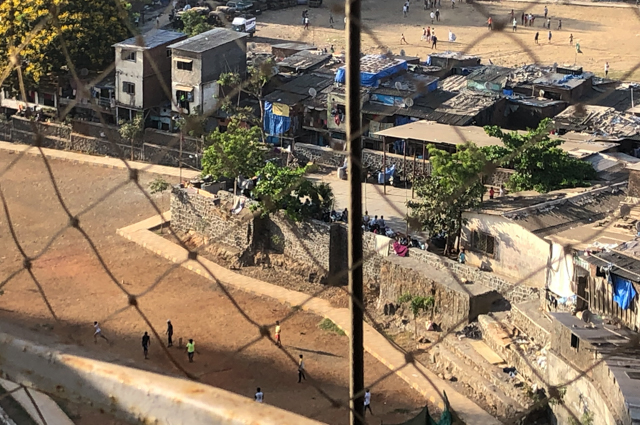
The K-West ward of Mumbai. All photos by Madhav Pai/WRI
Inequality is shaping how people are experiencing COVID-19 in cities to a startling degree. The vulnerability of the urban poor is striking everywhere, but the divide is more visible in some places than others.
This is where I live on Veera Desai Road in Andheri, within the K-West ward of Mumbai. Our neighborhood has the third highest cases of COVID-19 in the city. But I feel perfectly safe in my home. It feels more like a fortress.
Vendors with vegetables, fruits, bread and eggs all come into our building. There’s very little I or any of the 700-800 residents in the building need to step out for. We can order food from restaurants, groceries from online delivery stores. We have everything we need and most things we desire.
We work from home, my daughter attends school online. We can entertain ourselves with movies, TV shows and cooking.
We have a private open area for the complex that provides ample space for short walks and bicycle rides for my daughter every evening.
The only real hardship we face is that domestic workers cannot come to the house and we have to cook and clean on our own.

Looking south from my apartment, I see more high-rise buildings. People in these apartments have more or less the same experience as mine.

Looking north shows a very different picture. My window overlooks Basti, an informal settlement. This is a quiet afternoon; women and children sit outside their homes, tired after the morning’s housework. There is hardly any social distancing.
Homes are less than 100 square feet. Typically, three to four adults share space with another three to four children. There’s only enough space for everyone to sleep once household items are stacked up along the walls.
As colleagues have noted, what does social distancing really mean in this context? How will they manage it?

It’s evening. Kids have escaped their tiny homes and are out playing in the open spaces.
Some in the surrounding high-rises call the police, complaining about lockdown orders being defied. But what choice do they have? If they stay inside, they will watch TV or play on a smart phone shared with siblings and parents. There is violence in many of these homes. Getting outside to play is a critical mental and physical respite for these kids.

Hundreds of idle autorickshaws hint at the number of daily wage workers without work. None have moved since India’s lockdown began on March 25.
Many drivers are migrants and rent these vehicles on a daily basis. Some have managed to go back to their villages; others are hanging around.
They could be shifted into action for delivery services. They will have to be given social distancing training, but at least some workers could get back to earning money. Some cab aggregator companies are beginning to do exactly this.

Most residents don’t have direct access to water. You can see some homes storing water in little containers outside the house. Three buckets might last for the day. Regular hand washing will be a challenge for these households.
The summer is on us. Temperatures will increase as we go into the month of May. These homes get very hot. If this continues, staying indoors will be a health risk in and of itself and increased use will further stress water access.

This is the future site of the Mumbai Metro Line 6. They have just begun digging. From what I can gather, they are getting soil samples. This expansion is part of 330 kilometers of new metro planned in the city. Some portion of financing for the project has been secured, but the city is still negotiating financing for other parts, like new vehicles. I pray the economy is not hit so badly that some of this crucial public transit infrastructure will be delayed.
Indeed, the value of all public goods seems clearer than ever during the COVID-19 pandemic. We are all in this together, and what happens to one of us, affects us all. The housing divide is stark in cities like Mumbai. But look closer and you see that it’s only the tip of the iceberg. Water, sanitation, employment, transport, public space – for cities to work, we must do more to bring greater access to all kinds of services for all kinds of residents. Without more equitable access, there is no resilience.
My window provides a view into challenges that cities not only in India but across the global south face in the context of COVID-19. We must find ways to extend social and health protections to informal workers; expand access to quality affordable housing and public spaces; ensure delivery of basic services to all; and protect large infrastructure projects that help bridge the urban services divide, like Mumbai’s metro, from financial ruin.
My hope is that the crisis helps cities finally see and understand the hardships faced by the informal economy workers. And this knowledge – and the fear of future shocks – allows us to design stimulus packages that will help ensure cities are more inclusive and more resilient the next time.
Madhav Pai is Director of WRI India Ross Center for Sustainable Cities.





